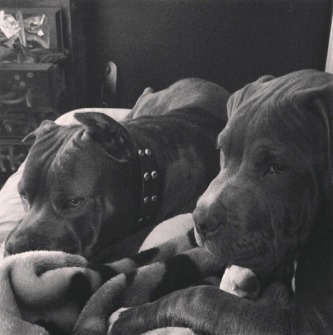The truth behind dangerous dogs

This is Grover(left) and Signs(right) laying down in bed. They are both pure American Pit bull Terriers.
While watching the news or listening to the radio, you may have heard about a domestic animal attack involving dogs like Pitbulls and Rottweilers. Most of the time, these animals carry a bad reputation and they are often categorized as dangerous, and vicious dogs.
Here are some of the top most reported dangerous dogs:
-Pit Bull
-Rottweiler
-German Shepherd
-Husky/ Alaskan Malamute
-Doberman
-Boxer
Every year, there are an estimated 4.7 million dog bites in the U.S. and nearly 800,000 dog bites require medical care, but by no means are these dogs dangerous or natural born killers. In fact, big dogs like Pit bulls, Rottweilers, and Dobermans are very loving, caring, loyal animals, and they make a perfect addition to any family.
The American Pit Bull Terrier is an extremely intelligent and strong guard dog that does well around young adolescents and adults. The Pit Bull is a good natured dog that is very obedient and works toward pleasing and protecting it’s owner.
The Rottweiler is an intelligent, self-confident dog that has an inherent desire to protect its home and family. It makes a great companion, as well as a great family and guard dog. The German Shepherd is also a great family companion and protector.
The Siberian Husky has an outgoing temperament and has the willingness to work. The Alaskan Malamute works well with other types of dogs and within all types of families.
Doberman Pinschers are very energetic, and they crave human interaction and leadership. Dobermans are loyal, tolerant, and affectionate. They also make a great watch and guard dog. The Boxer is also a great watch dog and loves to be around its family just like the Doberman.
All of these dogs are very compassionate and loyal pets that just want to be taken care of. However when neglected or abused by their owner(s), they may attack. You should never underestimate their strength and power. They do have the capability to cause a fatal injury, and sometimes even death.
Here are some tips on how to help control your dog and/or avoid being attacked by a dog:
-Never leave the dog around children while unsupervised. Approximately two-thirds of bites occurred on or near the victim’s property. 70% of dog bite fatalities occurred among children under 10 years old and 65% of bites among children occur to the head and neck.
-Restrain your dog. Approximately 24% of human deaths involved unrestrained dogs off of their owners’ property and approximately 58% of human deaths involved unrestrained dogs on their owners’ property.
-Train and socialize your dog. It is very important to teach your dog how to behave with other people and other animals. Try to introduce them to a variety of people, places, and animals during eight through sixteen weeks of age.
-You should not approach a dog you do not know. If it is tied up, behind a fence, or in a car you should still take precautions. If you find a stray dog, or any other animal, call the police or animal control.
-Do not treat the dog unkindly and do not abuse/neglect it . Dogs may become very aggressive when kicked, hit, or slapped. They also tend to become aggressive when their ears, tail, or paws are pulled.
Eighth grader